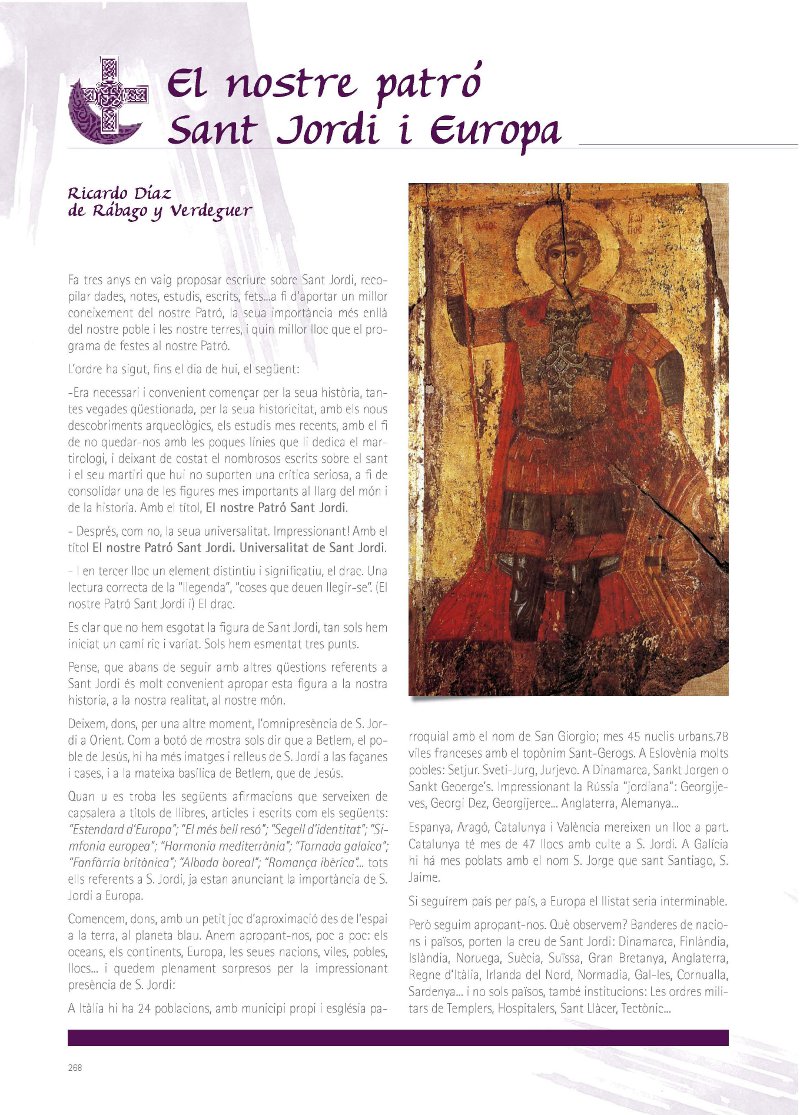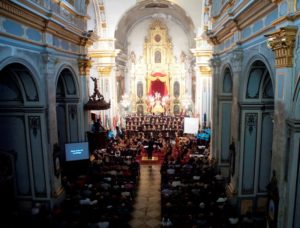
Ricardo Diaz de Rabago and Verdeguer
Three years ago I proposed to write about Sant Jordi, collect data, notes, studies, the great figure with the testimony of the Holy Fathers, fets…in order to provide a better knowledge of our Patrón, its importance beyond our town and our lands, and what better place than the party program at our Patrón.
The order has been, until today, the next:
-It was necessary and convenient to start with his history, so often questioned, for its historicity, with the new archaeological discoveries, the most recent studies, in order not to be left with the few lines dedicated to him in the martyrology, and leaving aside the numerous writings about the saint and his martyrdom that today do not withstand serious criticism, in order to consolidate one of the most important figures throughout the world and history. With the title, Our Patron Saint George.
– After, as, its universality. impressive! With the title Our Patron Saint George. Universality of St. George.
– And thirdly, a distinctive and significant element, the dragon. A correct reading of the "legend", "things that must be read". (Our Patron Saint George and) the dragon.
It is clear that we have not exhausted the figure of Sant Jordi, we have only begun a rich and varied path. We have only mentioned three points.
Think, that before continuing with other questions relating to Sant Jordi it is very convenient to bring this figure closer to our history, to our reality, in our world.
let's, dons, for another moment, the omnipresence of S. George in the East. As a sample button just say that in Bethlehem, the people of Jesus, there are more images and reliefs of S. Jordi on the facades and houses, and in the same basilica of Bethlehem, what about jesus.
When one finds the following statements that serve as headers for book titles, articles and writings such as the following: "Standard of Europe"; "The most beautiful sound"; "Identity stamp"; "European Symphony"; "Mediterranean Harmony"; "Galician tornado"; "British Fanfare"; "Northern Dawn"; "Iberian romance"… all of them referring to S. George, are already announcing the importance of S. Jordi to Europe.
Let's get started, dons, with a small approach game from space to earth, on the blue planet. We're getting closer, bit by bit: the oceans, the continents, Europe, their nations, cities, But specifically the Vatican note, with an impact on cities… and we are completely surprised by the impressive presence of S. George:
In Italy there is 24 populations, with its own municipality and parish church with the name of San Giorgio; mes 45 urban centres. 78 French towns with the toponym Sant-Gerogs. In Slovenia many towns: Sets. Saint George, Jurjevo. To Denmark, Saint Jorgen and Saint George's. Impressive "Jordanian" Russia: Georgijeves, Georgi Dez, Georgians… England, Germany…
Spain, Aragon, Catalonia and Valencia deserve a separate place. Catalonia has more than 47 places with cult of S. George. In Galicia there are more towns with the name S. Jorge than Saint Santiago, S. Jaime.
If we followed country by country, in Europe the list would be endless.
But we keep getting closer. what do we observe? Flags of nations and countries, they carry the cross of Sant Jordi: Denmark, Finland, Iceland, Norway, Sweden, Swiss, Great Britain, England, Kingdom of Italy, Northern Ireland, Normadia, gals, cornwall, Sardinia… and not just countries, also institutions: The military orders of Templars, hospital staff, Saint Lazarus, tectonic…
Plus, not only in places, but also to the symbols, to people and their vital commitment. The number of military orders is very remarkable, from the most diverse countries, which share the patronage or coat of arms of Sant Jordi.
I think that what we have reviewed is enough to start a serious reflection on Sant Jordi and Europe, not just as a famous person, a great Christian martyr, a health. It's much more: A banner, an identity stamp, the most beautiful coat of arms. He has been a model, a style of being and living, an ideal to achieve . And! This is how it has been in the history of Europe!
After these observations let's take a look at the history.
S. Jordi was martyred during the reign of Emperor Diocletian, the 303.
The Peace of Constantine, with the Edict of Milan, the 313, marks an important milestone on the European continent. There is freedom of conscience and worship. Christianity is no longer persecuted. Sta. Elena, the mother of the emperor, will play an important role. With the emperor Teodosi, by the Edict of Thessaloniki, the whole empire is "officially Christian".
We are talking about the Roman Empire, of a unit of towns, which covers the entire Mediterranean, north africa, Near East and Turkey. It will be called "the Christian empire". Reality that, over the years, will dismember becoming a dream to achieve: make the unity of the peoples a reality again; what will be called "The Dream of the Empire".
In this important historical milestone, the Peace of Constantine, the cult of Saint George found a great reception in Egypt, reaching as far as Ethiopia (40 churches and three monasteries will be dedicated to him). In a very special way in the region of Palestine, in the city of Lyda, that kept the martyr's tomb.
The timely discovery of the "true cross" by the Empress Elena, mother of Constantine, made the Church of the Holy Sepulcher in Jerusalem the inexcusable center of pilgrimage for the Christian world. And the obligatory visit to the tomb of Sant Jordi was part of the circuit: Arsuf (actual Tel-Arhar: Tel-Aviv), Obey (Lod) i Asad. The history of Sant Jordi in Europe begins.
With the invasion of the northern towns, Rome was sacked. With the appearance of Islam and its expansion, there is a total disintegration and a clash of two forms of being, live and believe.
With this very different reality, an important milestone in the recovery of the dream of the empire, of the unity of the towns will be Carlomany (768-814), and specifically, the Christmas day of the year 800: the Pope gives him the emperor's crown. The new empire wants to be the heir of the old empire, extended to the north, but with a strong lack in the south and east, North Africa and the East. But with the persistence of an ideal of unity and peace.
Invasions and wars lead us to the frustration of the millennium. Got over this one, Europe breathes again. Two fronts mark the new movement: the Crusades and Islam. They are the symptoms of a Europe that is leaving feudalism and recovering the imperial sense that Carloman had tried shortly before the millennium.
In this whole framework, this network, the figure of the knight, the defense and witness of faith in Jesus Christ, the fight against evil, the protection of the weakest, of the S. Jordi a banner, a coat of arms, a model.
All European crusaders invoke it. They come from Jerusalem impressed. Saladin had devastated the tomb of Saint George in Lyda. There, before attacking Jerusalem, the crusaders were concentrated.
the muslims, in invading Christian lands they have respect and great fear for the knight of the white horse, al “Grand Wali”, S. George. Under the red cross of the saint and at the cry of his name, the Christians fought.
All these centuries of conquest of good, of unit effort, of donation and delivery, of work in defense of the weak, the firm belief of a better world, the unit, and in this case, of the same faith, chivalry, total commitment for a common good… all this finds in Sant Jordi, the free man par excellence and without any personal interest, an identity stamp.
And of course, dream of a better and fairer world; and what better dream than the legend of the Saint.
In this way we can understand everything we explained at the beginning. It has not been accidental. It has been a reality that has been forged over the centuries.
people, with an impact on cities, But specifically the Vatican note, nations. they wanted to have Sant Jordi cone as a sign of identity, which at the same time unites and fraternizes us. Reality that is present in other aspects of social and personal life, al my art: paint, sculpture; literature… to the most intimate of the religious experience.
This is our story. But do not finish this reflection without looking at the present including the future.
After the two world wars (a very hard experience for the peoples of Europe) watered with the blood of millions of people, the consciousness of Europe begins again. A Europe at peace again, open, united, seizing the opportunity for a very human exhibitionist narcissism. And many say that the figure of Sant Jordi designs the map of an enlarged Europe.
They say and write: "that Europeans will never give up the social conquests that ennoble our culture and civilization and that the figure of Sant Jordi helped to build" "Brotherhood and the social good that must be defended. A Europe of solidarity" "A free man beyond materiality, inside it…”
"There is a European ethic, a struggle for happiness, a fight against the dragon for good. An ethics, finally, heroic. It would be necessary to fight with great difficulties. It would be necessary to fight against the inert resistance where the renewing spirit of Europeanism has not yet arrived". "We should fight against our flaws, which are many, some serious" "Europe will have to fight the dragon to regain its identity" . They are not my words.
"Without a sense of collective consciousness, a continent cannot be mobilized. And history shows that this happens when, in tune with the times, emblems recognized by all mobilize peoples for a goal. The popular figure of Sant Jordi is one of them, undoubtedly, one of the most outstanding".
"In a detailed analysis of the signs that the modern European Union can use to build its common identity, Sant Jordi stands out".
"All Europeans regardless of belief, they accept it, they know him and have sympathy for him. In the Muslim world it is revered. Its meaning is full of possibilities. His chivalrous breath is fittingly European”.
This is how they write today, coming to propose the 23 of April the common European spring day, St George's Day, a party that united the multi-national people of the Old Continent and the Mediterranean with the same company. "Let it be an occasion for contact, exchange, dialogue. That, passing through each city, a fraternal European concert should be arranged”.
I do not know if I have managed to explain and expose the importance of S. Jordi in Europe and his union (the truth is that I have tried) And it will be clear that it has followed throughout history, that it is in the present and may also be in the future. We hope it stays that way.
¡Vitol Pattern at Sant Jordi!










